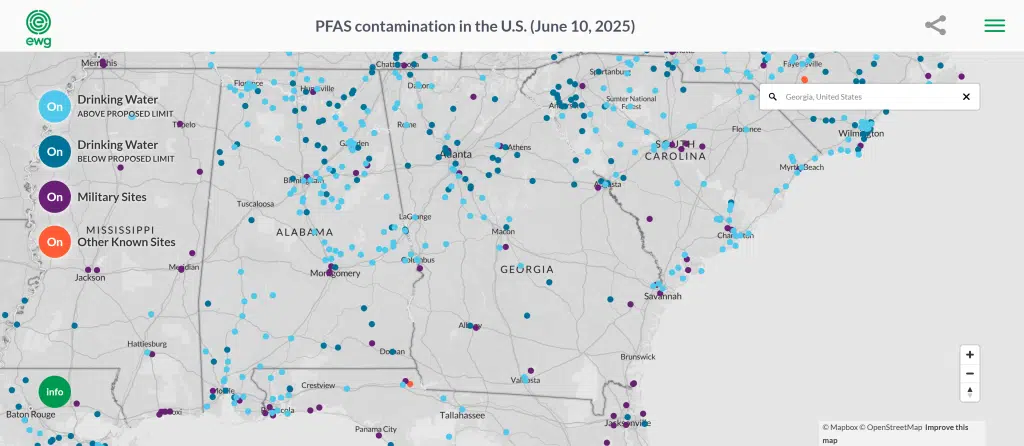- Home
- Personal Injury
- PFAS Lawsuit
- PFAS Contamination Map
- PFAS in Georgia
PFAS in Georgia
- Last updated: July 16, 2025
-
Contributor: nicky

I have closely followed the issue of PFAS Georgia contamination to understand why so many residents worry about these so-called forever chemicals. PFAS, or per- and polyfluoroalkyl substances, have been used in industrial and consumer products since the 1940s. However, they do not break down easily and can linger for years in water, soil, food sources, and the human body. The Environmental Protection Agency (EPA) in March 2023 reported that more than one million people across the state may have been exposed to PFAS in their drinking water, raising serious health concerns.
PFAS contamination is not limited to one part of the state. Experts have identified elevated PFAS levels in communities such as Clayton County, Augusta, and Calhoun, with some readings far above the proposed federal standards of 4 parts per trillion (ppt). Military installations, including Fort Benning (officially renamed Fort Moore), have also reported groundwater contamination, primarily from firefighting foams used in training. This contamination has led to discussions about potential legal claims from individuals who lived or worked near polluted sites and subsequently developed certain illnesses.
While Georgia officials have launched investigations and started monitoring water systems more rigorously, I believe there is still crucial information the public needs. This article offers verified facts, context, and the steps you can take if you suspect PFAS exposure has harmed your health. If you have questions about testing your water, filing a lawsuit, or understanding how PFAS laws affect you, I hope the sections below will provide the clarity you need.
What are PFAS and why are they a concern in Georgia?
PFAS are synthetic compounds designed to resist heat, water, and oil. These beneficial properties have made PFAS a staple in products such as non-stick cookware, waterproof clothing, food packaging, and firefighting foams. Despite their widespread use, the same chemical qualities that make PFAS durable also mean they accumulate in the environment.
Georgia’s growing concern centers on how PFAS can enter local drinking water systems, accumulate in fish and wildlife, and build up in human tissue over time. Studies by the Centers for Disease Control and Prevention (CDC) show that most people in the United States already have some level of PFAS in their blood. Here in Georgia, multiple communities exceed the EPA’s recommended PFAS levels in drinking water by large margins. In Augusta, the readings have been recorded at more than 1600% beyond the EPA’s minimum reporting levels, while Clayton County has seen 500% levels above that threshold. Meanwhile, Calhoun faces a federal lawsuit over water contamination due to PFAS, indicating the legal and health stakes are rising.
Part of the urgency stems from health studies linking certain PFAS chemicals to cancers, thyroid dysfunction, and other chronic conditions. The EPA has taken steps to tighten acceptable limits for key PFAS compounds like PFOA and PFOS, setting them at 4 ppt. While these regulations are a starting point, not all water sources have been tested, and not every affected person is aware of how to protect themselves.
Where are PFAS found in Georgia?
PFAS hotspots often correlate with industrial activity, wastewater plants, military bases, and firefighting foam training sites. According to a 2022 Waterkeeper Alliance study, PFAS contamination is widespread in major U.S. rivers and extends into several Georgia waterways, including the Chattahoochee, Altamaha, and Savannah Rivers. This puts local populations at risk as they rely on these sources for drinking water and irrigation.
Military installations remain a focal point. At Fort Benning, PFOS levels in groundwater once measured 3,250 times above the EPA’s previous advisory limit, while PFOA levels were 300 times higher. The contamination traces back to the use of Aqueous Film Forming Foam (AFFF) for firefighting drills and emergency responses. Over decades, the foam seeped into the soil and water table. These findings mirror what has transpired at other U.S. military sites, where at least 455 installations have reported PFAS contamination as of August 2023.
Industrial areas also contribute significantly to contamination. Several manufacturing facilities that use or produce products with PFAS can emit these chemicals into nearby water and soil. Beyond major urban centers, even smaller municipalities have discovered PFAS present in local wastewater streams, heightening the concern for well-water users and residents in rural areas.
PFAS in Georgia’s drinking water
Multiple regions in the state have tested above the EPA’s proposed thresholds for PFAS, which creates alarm among public health officials. In addition to Clayton County, Augusta, and Calhoun, I have noticed that the Atlanta area has PFAS levels 66% higher than the federal minimum reporting levels. Current research links PFAS exposure to serious health issues, including an increased risk of kidney and testicular cancer, high cholesterol, thyroid disease, and potential effects on a child’s development.
Many water systems have responded by expanding monitoring, upgrading treatment facilities, or issuing public advisories. Some utilities explore costly solutions, such as reverse-osmosis filtration plants, to reduce contaminants. In April 2024, the EPA finalized its maximum contaminant levels (MCLs) for six types of PFAS, including PFOA and PFOS at 4 ppt, and PFNA, PFHxS, and GenX at 10 ppt. Water providers in Georgia are expected to adapt their operations over time to comply with these new rules, although full statewide implementation can be slow.
That delay is especially concerning if you rely on private wells. Recent data indicates that at least 19 million Americans in 43 states have PFAS contamination in their drinking water systems, with some estimates suggesting up to 110 million people could be affected. While the exact numbers for Georgia are still being collated, I recommend that private well owners test their water independently if they suspect contamination.
PFAS in Georgia’s soil and agriculture
Soil contamination is another area of concern for Georgia residents, especially in agricultural communities. PFAS in soil can transfer to crops, livestock feed, or local water sources, and this cycle can potentially bring these chemicals into the human food chain. Although comprehensive soil testing is less common than water testing, the Georgia Department of Natural Resources and other agencies are beginning to focus on contaminant mapping.
In areas like Calhoun, high levels of PFAS have been discovered in wastewater or sludge applied as fertilizer, sparking fears that farmland might absorb these chemicals. Over time, crops grown in contaminated soil could accumulate PFAS. Livestock may ingest PFAS-laden feed or water, further disseminating these substances into the environment and eventually human diets.
There is ongoing debate among agricultural researchers about acceptable PFAS levels in soil. I have watched as states like Michigan, Wisconsin, and North Carolina propose or adopt their own guidance. Georgia is gradually joining these efforts by collaborating with universities and labs to analyze potential contamination. Although official statewide regulations for PFAS in soil do not yet exist, it is wise to exercise caution if you live in a high-risk zone. Testing soil on farms or gardens may provide early warnings of contamination.
Health effects of PFAS exposure
Health experts have studied PFAS for decades, especially PFOA and PFOS, two compounds common in firefighting foam and industrial processes. In lab animals, high PFAS doses correlate with certain cancers, immune system dysfunction, and reproductive difficulties. While human studies are more complex, many findings align with concerns about kidney cancer, testicular cancer, thyroid disease, high cholesterol, and potential low birth weight complications.
I recognize that not everyone exposed to PFAS will develop serious health problems. Factors like duration and level of exposure, individual genetics, and overall health status play roles in determining potential outcomes. That being said, the persistence of PFAS in the body is worryingly high. Estimates suggest that once ingested, PFAS can remain in a person’s bloodstream for years. This characteristic means even low-level, long-term exposure could pose risks, which is why public health officials emphasize reducing or eliminating PFAS sources wherever possible.
PFAS-linked diseases in Georgia
Numerous scientific investigations have associated PFAS exposure with specific diseases. Georgia residents, particularly those in areas with confirmed water contamination, may want to stay alert to related health findings. Below are four conditions often linked to higher PFAS exposure.
Kidney cancer
Researchers have noted significant associations between PFAS exposure, particularly PFOA, and kidney cancer. A study from the mid-2000s found elevated kidney cancer risks in communities near PFAS production sites. In Georgia, medical professionals sometimes advise individuals with known exposure—such as those who lived near Fort Benning or in communities reporting excessive PFAS levels—to undergo regular checkups. Early detection of kidney cancer often improves treatment outcomes.
Testicular cancer
Testicular cancer is another disease that has been linked to PFAS. Although still under study, testicular tumors have appeared in both lab animal research and epidemiological surveys of exposed populations. This cancer typically affects younger men, who may not always connect their diagnosis to environmental toxins. Regular medical screening and awareness are recommended steps for those who suspect long-term PFAS exposure.
Thyroid disease
I have seen multiple reports citing thyroid dysfunction as a potential consequence of prolonged PFAS contact. Thyroid disorders can manifest as hypothyroidism or hyperthyroidism, leading to symptoms like fatigue, weight changes, and temperature sensitivity. Georgia physicians may investigate PFAS exposure in unexplained thyroid cases, especially if there is a plausible environmental link to contaminated water or soil.
Liver damage and cholesterol changes
PFAS can also affect the liver, with some studies finding a correlation between exposure and higher levels of liver enzymes, indicative of liver injury. Elevated cholesterol is another concern. Although not all individuals experience significant cholesterol changes, certain studies show a relationship between PFAS levels in the blood and increased LDL cholesterol. These aspects might appear as subtle health shifts but can become clinically relevant over time.
How Georgia is responding to the PFAS crisis
Georgia’s response to PFAS contamination is still evolving. State agencies have started taking water samples and identifying hotspots. Some local water utilities have upgraded treatment methods, such as installing membrane filtration systems or granular activated carbon. Lawmakers have also held informational hearings about whether to adopt statewide PFAS regulations similar to states like Wisconsin, where enforceable limits and hazard indices help protect residents.
Several civil lawsuits have emerged, aiming to hold polluters accountable for remediation costs. Calhoun, for instance, faces litigation from the Southern Environmental Law Center over PFAS pollution in local water systems. On the federal level, the EPA finalized maximum contaminant levels for key PFAS chemicals in April 2024, requiring water systems to keep PFOA and PFOS below 4 ppt. Additional substances—PFNA, PFHxS, and GenX—face a combined limit of 10 ppt.
State officials also focus on public awareness and interagency cooperation. Researchers from Georgia universities are analyzing new approaches to advanced water treatment, including proposed technology for in-situ soil and groundwater remediation. Despite these efforts, budget constraints and regulatory complexity may slow progress. Because of that, personal vigilance remains necessary if you suspect water or soil contamination around your home.
Can you test your water or soil for PFAS in Georgia?
Yes, and I strongly recommend it if you believe your property might be affected. In many cases, local utilities will publish water quality reports that detail contaminants, including PFAS. If you rely on well water, you can order specialized PFAS test kits from certified labs. These tests typically analyze concentrations of PFOA, PFOS, and other PFAS variants in parts per trillion. Costs vary, but some community organizations or county offices offer subsidized testing for low-income residents.
Soil testing is less common yet equally important if you garden or farm in areas with known or suspected contamination. Although Georgia does not have a universal standard for PFAS in soil, the EPA and other state environmental agencies provide guidelines to help interpret soil test results. When farmland is involved, I encourage you to examine best practices for mitigating or containing PFAS contamination, such as applying layered soil amendments or using alternative irrigation sources.
Do you qualify for a PFAS lawsuit in Georgia?
High PFAS exposure in Georgia has prompted an increase in legal claims against manufacturers and other parties responsible for polluting water and soil. You may qualify for a lawsuit if you meet basic criteria such as:
- Documented PFAS exposure in a contaminated area (for instance, living near Fort Benning or in counties like Clayton, Augusta, or Calhoun).
- A medical diagnosis commonly associated with PFAS-linked conditions, such as kidney or testicular cancer, thyroid disease, or other serious health issues.
- A plausible connection between your exposure timeline and your medical condition.
These lawsuits often address the expenses linked to health care, lost wages, and diminished quality of life. If you suspect your exposure originated from a specific polluter, consulting a legal professional could clarify your options. Besides personal injury claims, class actions or mass tort litigation may address widespread community harm. Many attorneys now specialize in PFAS cases due to the increasing scientific consensus about their health risks.
If you would like more information on PFAS lawsuits, the following pages may help:
Why choose Legal Claim Assistant
I realize how daunting it can be to tackle a PFAS lawsuit alone. Identifying legal grounds, gathering medical evidence, and negotiating with corporate defendants or insurance companies is complex. By working with Legal Claim Assistant, you gain:
- Access to a network of specialized attorneys, each experienced in handling PFAS claims.
- Assistance reviewing your medical and environmental exposure records.
- Transparent updates on your legal options, whether you decide to file an individual or class action suit.
- Clear, fact-based guidance on the potential timeline and steps involved in seeking compensation.
These advantages can make a meaningful difference in the outcome of your case. I see many individuals who do not pursue legal action simply because they are unsure where to begin. Legal Claim Assistant helps bridge that knowledge gap, offering resources and professional support that can demystify the entire process.
Frequently asked questions (FAQ)F
PFAS problems are often concentrated around military bases, airports, and industrial sites. For instance, seven spring sites near Deltona tested above EPA’s MCL. The University of Florida’s interactive map offers local insights into high-risk areas.
If you live in another state, you might also find PFAS contamination in your area. For instance, you can see ongoing monitoring updates in Minnesota or New York, as PFAS contamination can cross state borders.
Yes. You can contact certified labs or check with your county health department to learn about testing kits. Some municipalities provide these services at reduced cost.
Florida is expected to propose adopting the EPA’s 4 ppt standard for PFOA and PFOS by January 2025, according to FDEP communications. Public water suppliers must test regularly and, if necessary, improve filtration to meet these limits.
Agricultural operations that rely on contaminated irrigation water or use biosolids with PFAS may face soil buildup of these chemicals. The state does not yet have formal PFAS limits for soils, but FDEP is investigating how farmland contamination could affect produce and livestock.
Recent studies have linked PFAS exposure to kidney and testicular cancers, thyroid disorders, liver damage, and cholesterol disruptions. However, the severity of effects can vary based on exposure duration and individual health factors.
Yes. If you suspect serious health or property damage from PFAS, you may have a claim against manufacturers or other responsible parties. I recommend connecting with Legal Claim Assistant for a free review and more detailed guidance on filing a PFAS lawsuit in Florida.
Overview PFAS contamination in the USA
Here you van find the PFAS watercontamination map of the United States. Find, state by state, where water contamination has occurred due to PFAS exposure.
- PFAS in Alabama
- PFAS in Alaska
- PFAS in Arizona
- PFAS in Arkansas
- PFAS in California
- PFAS in Colorado
- PFAS in Connecticut
- PFAS in Delaware
- PFAS in Florida
- PFAS in Georgia
- PFAS in Hawaii
- PFAS in Idaho
- PFAS in Illinois
- PFAS in Indiana
- PFAS in Iowa
- PFAS in Kansas
- PFAS in Kentucky
- PFAS in Louisiana
- PFAS in Maine
- PFAS in Maryland
- PFAS in Massachusetts
- PFAS in Michigan
- PFAS in Minnesota
- PFAS in Mississippi
- PFAS in Missouri
- PFAS in Montana
- PFAS in Nebraska
- PFAS in Nevada
- PFAS in New Hampshire
- PFAS in New Jersey
- PFAS in New Mexico
- PFAS in New York
- PFAS in North Carolina
- PFAS in North Dakota
- PFAS in Ohio
- PFAS in Oklahoma
- PFAS in Oregon
- PFAS in Pennsylvania
- PFAS in Rhode Island
- PFAS in South Carolina
- PFAS in South Dakota
- PFAS in Tennessee
- PFAS in Texas
- PFAS in Utah
- PFAS in Vermont
- PFAS in Virginia
- PFAS in Washington
- PFAS in West Virginia
- PFAS in Wisconsin
- PFAS in Wyoming
Related Article

What Philips CPAP Machines Are Recalled and Why

